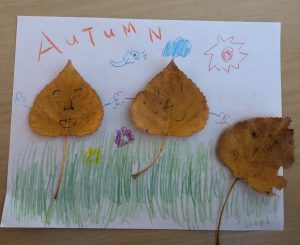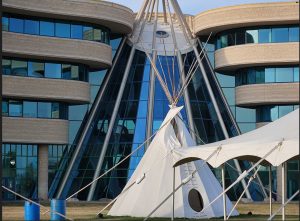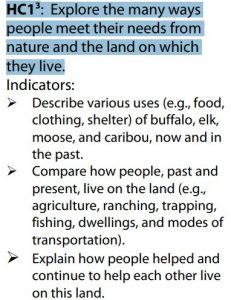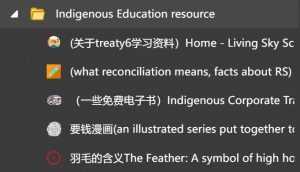
“Happy leaves who are holding hands” is my learning project for this week.
What is Reconciliation?
I went to the First Nations University of Canada on September 30th, National Truth and Reconciliation Day.
As an international student, most of my understanding of Indigenous culture and knowledge comes from textbooks. As a student at U of R, I only went to this federated college for classes.
Although people will mourn for the victims of residential schools on this day, I believe the more important thing is to make a better future by forging a relationship between Indigenous Peoples and settlers.
But how to? My answer is: to educate ourselves.
Here is a Ted talk, in which the host talks precisely in an authentic and unusual narrative about what Reconciliation is and is not:
I will summarize in bullet points in the video.
Reconciliation is (the host starts this part at 6:55):
- to learn about traumas, Indigenous cultures, Indigenous resilience to colonization, and Indigenous peoples’ contribution to Canada initiatively.
- to be a good listener to Indigenous peoples’ stories.
- to integrate Indigenous content throughout the curriculum.
- to advocate for Indigenous peoples genuinely.
- to donate time and money to Indigenous leadership.
Reconciliation is Not (the host starts this part at 2:32):
- tokenistic.
- about beneficence, “Charity is not positive if the recipient feels indebted, it is another form of power imbalance.”
- performative allyship.
- expecting Indigenous peoples to educate you.
My inspiration at FNUniv
After watching the video, I decided to go to the First Nations University of Canada to do some practical self-learning because it is the nearest place for me to immerse myself in Indigenous traditions and environments. “Indigenous environment” is a self-created word, I am not sure if it is appropriate. The reason I created it is that the First Nations University includes many Indigenous symbols. It is different from modern architecture in appearance and color. The appearance of the university is a big tipi:

The front view of the First Nations University of Canada
In the university, there is a small tipi made of tempered glass. There are feathers and cushions in it. I didn’t take pictures of the inside because there is a notice saying that it is a sacred place and photos are not allowed.
I found a seat, which is located in front of the glass tipi, and began my observation which was no more than looking around and connecting what I saw with prior knowledge. However, a weird thing happened. I suddenly got the inspiration for the learning project. I believe my inspiration came from this round building. I felt safe in this building as if some power were protecting and inspiring me.
The learning project
My learning project is a handcraft made of yellow leaves in the autumn. I created a video tutorial that records the creating process. In the video, I discuss my inspiration, the required materials, detailed procedures, and the possible connection to Grade 1 ‘s curriculum.
The keywords of this handcraft are autumn, nature, hands-on activity, human, emotions, and collaboration.
A video subtitle tool
The tool I used to insert subtitles is Aegisub. It is free and open-source software. It supports many languages. You can get different text effects if you insert the corresponding codes. In my video, I created a moving subtitle by adding the code “{/move(x,y,x,y)}. You can know where to put the subtitle by the sound wave which can be zoomed in for accurate editing. Anyway, there are several tutorials on Youtube. Just type “Aegisub” in the search box, and you will find the adequate information you want.
Curriculum connections
The last part of my video is about the connection between curriculum and my handcraft. I will list some learning outcomes that this handcraft might fit into.
Grade 1
Subject: Science
Learning outcomes: DS 1.1, DS1.2
Subject: ELA
Learning outcomes: CC1.1, CC1.4
Treaty Education outcomes:

Grade 1: Learning that we are all Treaty people
HC13 Explore the many ways
people meet their needs from
nature and the land on which
they live.
Indigenous knowledge resources
Reconciliation is about educating ourselves. Below are some online resources about Indigenous peoples.
- Supporting Reconciliation in Saskatchewan Schools: a website about what reconciliation means, 94 TRC Calls to Action and residential schools.
- Birch Bark Comics: an illustrated series put together to tell the Sacred Circle Story; suitable for lower grade students; books are not free.
- The National Centre for Collaboration in Indigenous Education(NCCIE): teaching resources, Indigenous stories, and lesson plans developed with an Indigenous perspective for teaching.
I recommend that we create a collection in our browser for bookmarking websites and information about Indigenous knowledge and Indigenous narratives.

My collection of Indigenous Education resources on Edge. I am a lifelong learner.

Hello! I love how you are taking the time to educate yourself on how to form a better relationship between Indigenous People and settlers. I too think that the best way that we can do this, is by continuing to educate ourselves. I watched that Ted Talk with Lori Campbell last week, and it really puts things into perspective!
This is awesome! I love how you took the time to learn about Truth and Reconciliation, something many people who have lived in Canada their whole lives have not done. Your project looks great and I can’t wait to see what else you create. Best of luck!